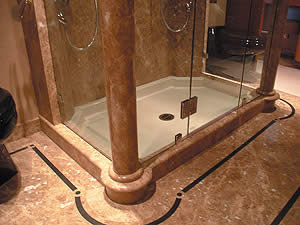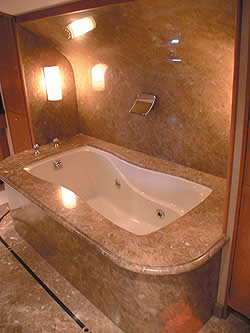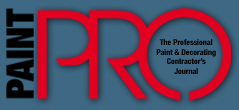
John Swartley,
Westport, Washington
by John Chandler
from the East Coast, John Swartley’s career has been anything but lost at sea.
As a decorative painting professional working with faux finishes and specializing in detail work, Swartley, 57, has had a steady and rewarding gig working with Westport Yachts in Westport, Wash.
There are inherent obstacles to painting the interior of yachts built in a production environment, but nothing too vexing, he says. And after ten years of working on these luxury boats, he’s got his part of the job down pat. “It’s kind of a strange little niche I’ve got here,” he says.
“Painting is my profession and I would say I fit the needs of the profession more than the other way around,” he says. “It’s worked out; I’ve worked for Westport for seven years. It means a steady working relationship with one company, and they have enough work to keep me busy — work that’s interesting, if not always challenging.”
 Swartley’s odyssey began in the halls of academia: He earned a degree in fine arts at the University of North Carolina at Chapel Hill. He later studied graphic design at Tyler University and University of the Arts in Philadelphia. Swartley’s odyssey began in the halls of academia: He earned a degree in fine arts at the University of North Carolina at Chapel Hill. He later studied graphic design at Tyler University and University of the Arts in Philadelphia.
The 1960s was a frenetic time for a young artist on the East Coast — rock music, Andy Warhol, etc. — and Swartley had his “bohemian” moments.
But as the ‘70s rolled around, his pragmatic nature guided him into the working world. He worked as a graphic designer and supplemented his income painting houses.
“I transitioned into decorative painting upon meeting a successful trompe l’oeil master, and worked on restorations of 18th-century homes and furniture in the Philadelphia area,” he says.
After several years of working full time in New York, glazing floors and walls, creating trompe l’oeil murals, gilding, and getting acquainted with faux marble and faux bois (wood), Swartley relocated to Seattle in 1991. Keeping busy as a decorative painter working for contractors, he eventually found his way into yacht work 10 years ago, and hooked up with Westport in 1997.
Westport builds luxurious sport ships that range between 30 and 50 meters in length. Swartley won’t divulge any celebrity customers, but indicates the ships are popular with corporate clients who use them for entertaining in the Caribbean and in Florida and New York.
“Yacht interiors have many challenges dictated by engineering and space design, balancing of materials and their weight,” he says. “Generally, the materials used in the manufacture of the yachts that I work on are fiberglass, aluminum and wood.” Much of his time is spent applying faux marble finish in the bathrooms of the ships’ master suites. The bathtub has a real marble or granite skirt and he paints the surrounding fiberglass to match the tub material. Joining one area to another aesthetically is the crux of his job.
 “I paint fiberglass, wood or metal to match marble, granite or wood,” he says. “I gild furnishings and cabinetry. Occasionally a milled, flexible rubber product is used to accommodate curves or contours and needs to match adjacent wood elements. The faux finishes are generally subordinate to the real materials and act to support the aesthetics in the spaces.” “I paint fiberglass, wood or metal to match marble, granite or wood,” he says. “I gild furnishings and cabinetry. Occasionally a milled, flexible rubber product is used to accommodate curves or contours and needs to match adjacent wood elements. The faux finishes are generally subordinate to the real materials and act to support the aesthetics in the spaces.”
His training in trompe l’oeil comes into play when the surface is wood. “Trompe l’oeil creates the illusion of raised panels with shadow and highlights,” Swartley says. “I’m creating the illusion of inlaid wood so it looks like marquetry. “In woodworking, that’s where you inlay different kinds of wood, on tabletops, for example. We build the furniture on the ships with two kinds of wood, a burl and a cherry, and so that’s something I imitate — the burl and the cherry together.”
Keeping his workspace clean and well lit is crucial to a successful project, Swartley says. He is, after all, working in a construction site. Much of the battle revolves around scheduling and making sure there isn’t a carpenter or other tradesman cluttering up his area. Good preparation is essential.
He swears by Benjamin Moore products for durability, opacity and color (though he usually mixes his own color). “I’ve found them to be the highest quality,” he says, “and the easiest to work with.”
For trompe l’oeil applications, Swartley favors combinations of water-based products from Benjamin Moore, Faux Effects, McCloskey’s, Liquitex and Golden. “I prefer non-yellowing water-based varnishes for topcoats. I use oil size [a ‘glue’ made from a linseed oil blend] and 23/24 karat gold for gilding, which resists corrosion.”
Swartley mentions Venetian plaster as a product that finds its way into a lot of his jobs. “I moved out from New York about 14 years ago, and Venetian plaster was a trend then, and now it’s being used in residential work out here. It’s taken a while to get here. It’s a popular finish.
“Venetian plaster has a sheen to it that’s like polished marble, but it’s not quite a perfect sheen,” he says. “It’s sort of a hand-rubbed, waxed look, alternating flat and shiny. There are a lot of products on the market that imitate it.” The interior of the yacht is always climate-controlled, so the elements don’t wreak as much havoc as they do outside. However, Swartley says, the yachts cruise anywhere from the Caribbean to Alaska, so different climates and moisture levels have to be considered. He sometimes utilizes Varathane, a water-based interior clearcoat for wood. He also says the crew at Westport occasionally topcoats his work in Emron, an automotive clearcoat.
Air quality isn’t a problem because Swartley uses quick-drying, water-based products. The shipyard also is equipped with ventilation systems, so fresh air is always circulating.
As far as the most difficult area to paint, Swartley again brings up the master suite bathroom: “It’s a forward bulkhead that goes the width of the boat and it’s sort of a reverse profile — it’s a slanted wall so I have to sit in the tub and paint overhead at a very strange angle. It’s tough on the back.”
Westport currently produces about nine boats a year, and Swartley estimates he’s worked on close to 50. While the designs are all standard, he says, there is still ample opportunity for creativity.
“If a client buys a boat before it’s finished, and they want to customize it, I have done specific trompe l’oeil on certain aspects, like the domes over the dining room tables,” Swartley says. “I’ve done several different painted illusions, and also gilded some of the domes themselves, which is maybe 20 square feet of gold leaf in different patterns.”
Knowing that his high-end interiors will travel to far-off ports is a source of satisfaction for Swartley, while working in a production environment gives him endless opportunity to refine the creative process. “Because I get to see the results very quickly,” he says, “I can work on creative improvement on the next ship.”

|

